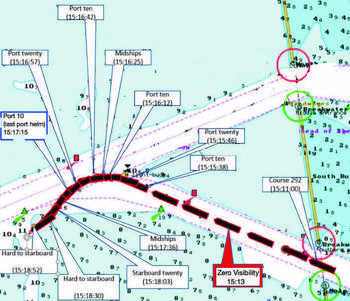202433 Unexpected fog throws bridge team into disarray
As edited from Taiib (Latvia) report 2-2018A loaded cargo vessel was outbound under pilotage in daylight and moderate visibility. A tug was in attendance but was released once the vessel was past the port breakwaters. About seven minutes after the tug departed the vessel, visibility unexpectedly reduced to about 200m. The vessel was at a speed of six knots, and over the next two minutes the pilot gave helm orders to make a 44 degree port turn out to sea (see diagram).
The vessel turned further to port than desired. Once the pilot realised this, he gave starboard helm orders, but it was too late. The vessel grounded outside the buoyed channel about four minutes after the first port helm order was given. Attempts to use ship’s power to return to the channel were fruitless and salvage tugs were needed.
The investigation found, among other things, that the vessel lacked a complete voyage plan to exit the harbour (ie courses, safety distances, clearing bearings, rate of turn etc.) and that the pilot was navigating primarily by visual means. When the visibility unexpectedly reduced, the bridge team were at a disadvantage. No one on the bridge was in control of the progress of the 44 degree port turn by electronic means such as ECDIS or radar.

Lessons learned
- A shared plan is a safer plan. In this case, the plan was in the pilot’s head, much as we saw in MARS 202153.
- Even with a pilot on board a Master should ensure courses are put on the chart or ECDIS and OOWs are closely following the progress of the vessel.
- Visual navigation in fog is a recipe for an accident.
- When in doubt, slow down if possible. In this case the vessel was at six knots which is not that fast – except they didn’t have good situational awareness. At 4 knots they would have had 50% more time to evaluate.
Editor’s note: Some past MARS reports with similar circumstances are MARS202153, MARS202154, MARS202155.
